4 Campus Sanctuaries to Enjoy Fall
Taking a break for fresh air improves brain activity and alleviates stress
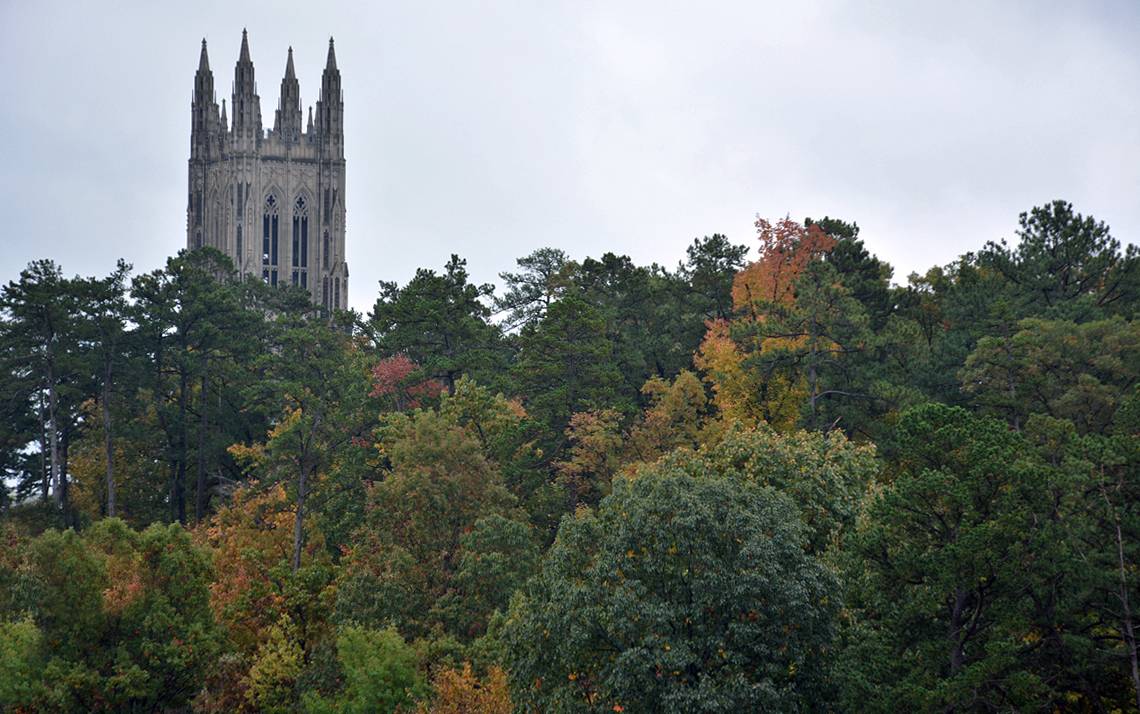
Donna Sell strolls across the rooftop garden at Grainger Hall, gently touching the orange-red leaves of the Mexican sunflowers.
The sunflowers bloom early in the fall and, with some nearly 4 feet tall, the flowers tower above other plants in the garden.
“They’re so bright and cheery,” said Sell, staff specialist for the Nicholas School of the Environment. “It’s such a refresher to walk up to the garden in the middle of the afternoon to take a break from my computer.”
Sell’s trips up to the rooftop garden, located on the sixth floor of Grainger Hall, have restorative effects. When she settles back at her computer, she feels more alert and focused.
From the rooftop of Grainger Hall to a sculpture garden behind Duke University School of Law, there are many campus sanctuaries to see the changing color of the leaves and enjoy the restorative power of fall.
“Breathing in fresh air gives your brain more oxygen, which allows you to function more efficiently,” said Tom Szigethy, associate dean of students and director of the Duke Student Wellness Center. “As we get into fall, the air is easier to breathe in because it isn’t stifling like it is in the summer.”
Check out a few places for a peaceful moment:
Seese-Thornton Garden of Tranquility
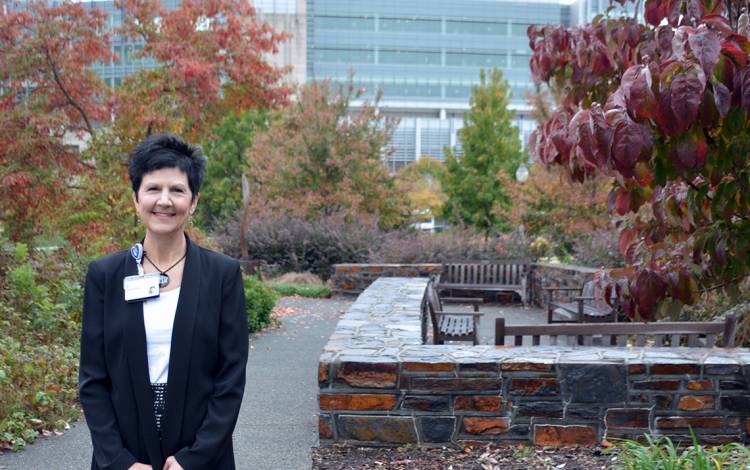
When Tracy Berger takes a seat in the Seese-Thornton Garden of Tranquility, she focuses her attention on the words “peaceful,” “tranquility” and “mindful.” The words are engraved in concrete on the garden’s path.
Berger repeats the words like mantras during her weekly visits to the garden across the entrance to the Duke Cancer Center. Berger, a medical family therapist for the Duke Cancer Patient Support Program, counsels patients and their families through the emotional hurdles of a cancer diagnosis.
“For me, the garden represents a restful and restorative space,” Berger said. “By taking time to nurture myself, I can be more supportive of the people I’m taking care of.”
The Garden of Tranquility was created in 2004 to provide an outdoor space for staff, patients and visitors to have meditative thought and reflection. The space features a dozen benches to take a seat in and observe the 18 words engraved into the concrete path, like “loved,” “supported” and “hopeful.” The open space also features elm, oak and ash trees that take on the reds, yellows and oranges of fall.
Berger encourages colleagues and patients to visit the garden when they’re feeling sad or stressed.
“The garden restores the soul by giving employees and visitors a natural pause between buildings that house stress, whether work or health related,” Berger said. “You feel a weight lifted off your shoulders.”
To learn more on how to make a tribute in honor or memory of someone in the Garden of Tranquility, call 919-684-4497.
Beber Sculpture Garden
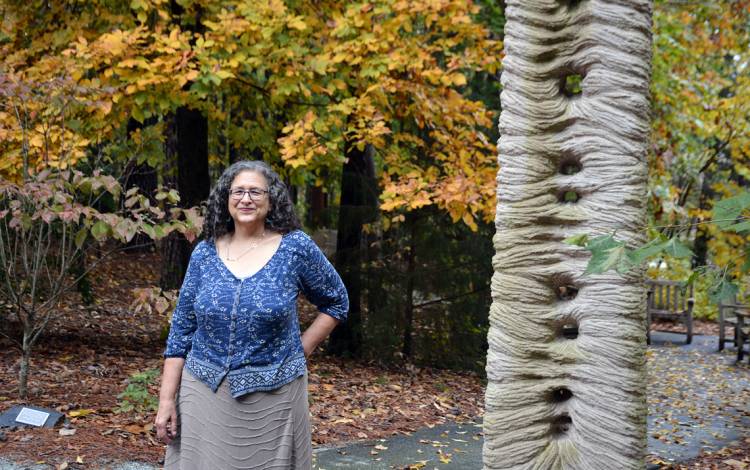
The crunching sound of Janet Silber’s foot on fallen leaves is the only sound breaking up the silence during her mid-afternoon walk at the Beber Sculpture Garden behind the Duke University School of Law.
The walk is a daily routine for Beber to re-energize after a busy season of planning donor recognition events and meetings for the Duke Law School’s Leadership Board.
“I feel ready to handle any challenges after a walk,” said Silber, the senior administrator for donor relations for Duke Law’s Alumni and Development Office. “It adds serenity to my days.”
The Beber Sculpture Garden, which opened in 2007, was made possible by Duke Law alumnus Bob Beber and his wife Joan, a graduate of the Women’s College. The garden sits under a canopy of pine trees and features seven sculptures, the majority of which were made by North Carolina artists. There’s also picnic tables and benches for an al fresco lunch or meeting.
“Access to beautiful spaces and art is a treat to working at Duke,” Beber said.
Duke Pond
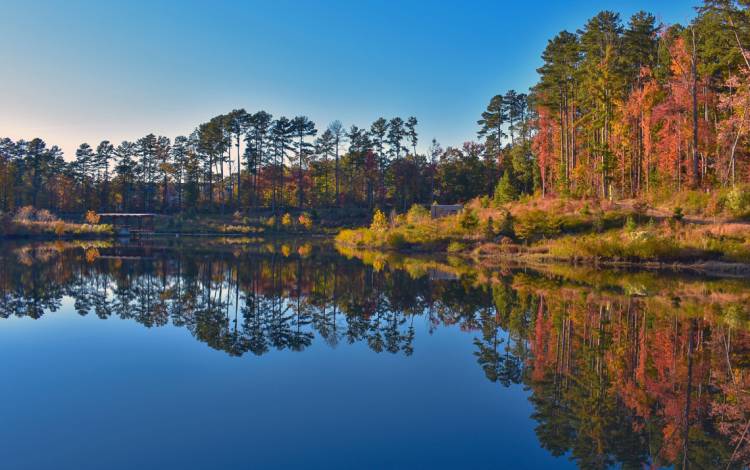
Duke’s reclamation pond, known as Duke Pond, is a beautiful spot for a stroll and key component to Duke’s water strategy. The pond provides water for the nearby Chiller Plant No. 2, which pumps cold water around campus to cool buildings. The pond saves around 100 million gallons of potable water annually.
The 5.5-acre pond features a .6-mile walking path, pavilion and boardwalk. The area is surrounded by red maple, sweetgum, sycamore and tulip poplar trees taking on fall hues.
“The pond is a great place to enjoy in the fall,” said Mark Hough, university landscape architect. “I love seeing it change with the seasons as the plants grow. It is unlike any other landscape on campus.”
Other Campus Spots
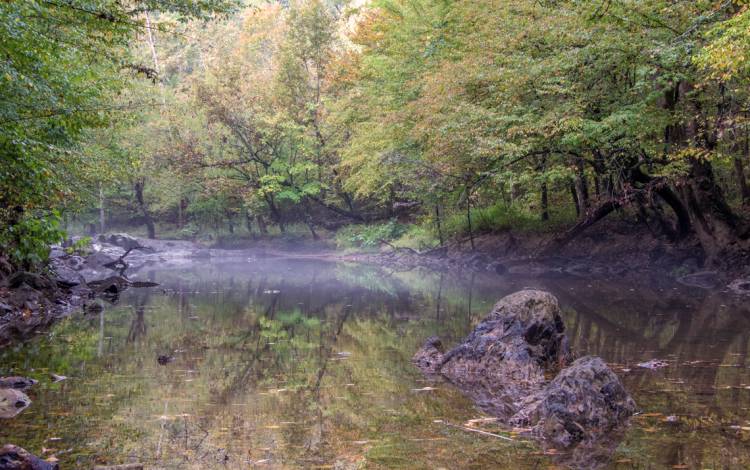
A garden behind the Duke Center for Integrative Medicine includes a labyrinth made of bright pebbles. There’s the Pratt Memorial Garden, the Fitzpatrick Center for Interdisciplinary Engineering, Medicine and Applied Sciences (CIEMAS) building, which has a circular seating area nestled up against trees. Also, take a moment of reflection in the middle of campus at the Murphy-Nimocks Meditation Garden behind the Duke Student Wellness Center.
Duke Forest is home to nearly a dozen species of trees that change colors in the fall. Look for sourwood, dogwood, hickory and oak trees next time you take a walk in the forest.
Finally, enjoy the diverse fauna at Sarah P. Duke Gardens. Climb the Historic Terraces, have a moment of reflection in the Garden of Peace and watch ducks at the Waterfowl Observation Area.
Have a story idea or news to share? Share it with Working@Duke.